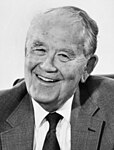| |||||||||||||||||
| |||||||||||||||||
 County results Burdick: 40–50% 50–60% 60–70% 70–80% Knorr: 40–50% 50–60% | |||||||||||||||||
| |||||||||||||||||
| Elections in North Dakota |
|---|
 |
The 1982 U.S. Senate election for the state of North Dakota was held November 2, 1982. The incumbent, North Dakota Democratic NPL Party (Dem-NPL) Senator Quentin Burdick, sought and received re-election to his fifth term, defeating Republican candidate Gene Knorr.[1]
Only Burdick filed as a Dem-NPLer, and the endorsed Republican candidate was cattle rancher Gene Knorr. Burdick and Knorr won the primary elections for their respective parties. Burdick's campaign was known for employing more television advertisement spending when compared with his campaigns in the past, as well as making several negative portrayals. Knorr had the support of Vice President George H. W. Bush, who campaigned in state to support his candidacy. The election was also noted as the first where Burdick's age began to become an issue. Burdick, who was 74 during the year of the election, faced a much younger Knorr, who was 41. At one point, Burdick challenged Knorr to a fistfight to prove his vitality; but the challenge, assumed to be a joke, never occurred. After being defeated, Knorr moved to Washington, D.C., where he took the position of staff vice president with Philip Morris International.
One independent candidate, Anna B. Bourgois, also filed before the deadline, running under her self-created party titled God, Family, and Country. Bourgois would later run for North Dakota's other United States Senate seat, an independent in 1986, challenging Mark Andrews. She received over 8,000 votes in the election, which is rather high for an independent. Some attribute her large number of votes to the name of her party – which was based on things that North Dakotans valued. Despite the result, Bourgois' campaign still had little impact on the outcome.
- ^ "Statistics of the Congressional Election of November 2, 1982" (PDF). Clerk of the House of Representatives. p. 32.

